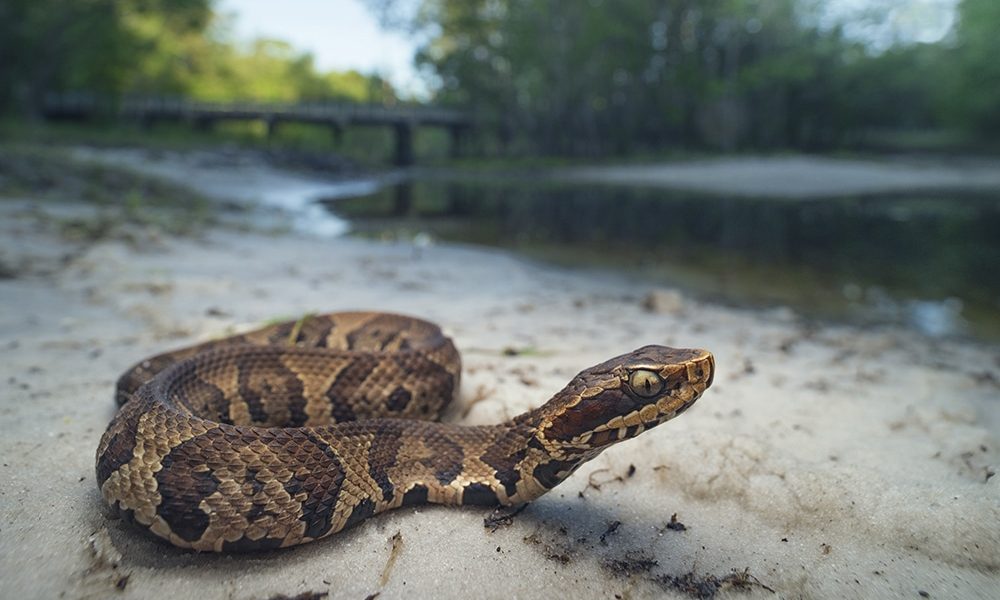Where Does a Water Moccasin Make Its Nest

The cottonmouth snake, Agkistrodon piscivorus gets its name because when it opens its mouth the interior is white like cotton. It's also called the water moccasin or water viper. It is a highly venomous snake and can be aggressive, so it needs to be removed by a professional when found inside the home.
About the Cottonmouth Snake
The cottonmouth is found in the southeastern part of the United States, most often in the swamps and other bodies of water of Florida, Louisiana, and Mississippi. It can grow up to six feet long and is a heavy-bodied, sluggish snake that's rarely found far from water. Because of this, it eats aquatic life such as frogs, fish, baby turtles, other snakes, wading birds, and other small animals found around water. They've even been known to eat carrion, which is unusual for snakes.
The venom of the cottonmouth is powerful and can be lethal. It won't move away if it's harassed but usually does a threat display before it actually bites. The threat display helped give the snake its name, for it opens its mouth widely. The white color contrasts vividly with the body of the snake, which is dark in the adult.
Besides gaping to warn a potential predator, cottonmouths whip their tails back and forth, raise their heads and coil up menacingly. They may spray a bad-smelling musk, much like a skunk. They can bite when they're in the water as well as on land.
What It Looks Like
Cottonmouths can grow to a little over 6 feet long and weigh a little less than 4 pounds. Males are larger. Both sexes have large heads shaped like spades with a patch of black, brown or olive on the top or sides. Though they may be hard to see at a distance, the adults often have brown and black bands on their bodies. These bands darken till they are wholly black at the animal's tail. The tail ends of juvenile cottonmouths are yellow and are used as lures. Their patterns are brighter than those of the adults.
Reproduction
The cottonmouth can breed all year but breeds most often in spring. The female carries her eggs inside of her for about five months. The babies are born when the eggs break open inside of her, and between one and 16 young emerge. Cottonmouths are a bit unusual for reptiles because sex is determined by genes and not by the environment as it is with turtles and crocodiles. The babies stay with their mother briefly before they go off into the world, and she may guard them for a time. Most don't live to adulthood as they're eaten by other animals, including snakes of their own species.
Before mating, the male snake performs a dance to draw a female towards him. Males also fight for mates. Cottonmouths are also notable in that they seem to be monogamous.
Female cottonmouths are mature when they're about three years old. The oldest cottonmouth snake lived to be 24 1/2 years old. This was a captive snake, and biologists don't know how long they live in the wild.
Sometimes, cottonmouth females undergo facultative parthenogenesis, where they can reproduce without a male.
How Cottonmouths Behave
Cottonmouths rarely stray far from water. This is especially true of adults. They're solitary, but during mating season the males try to establish a hierarchy. They usually hunt at night and can do this effectively because they are pit vipers. This means they have heat-sensing pits on their faces between their eyes and nostrils. The pits allow them to sense prey so accurately that they don't have to see them to strike. Their senses of touch, smell, sound, and vision are also good. Like all snakes, they don't have ears but can sense vibrations from the ground.
The territory of a cottonmouth snake is a little over a hectare and includes the body of water. Bigger snakes have bigger territories, and males have larger ranges than females. Like many other snakes, the cottonmouth snake hibernates in the winter in its northern range but is one of the last snakes to do so. It sometimes doesn't seek a hibernaculum until after a frost.
Cottonmouth Venom
The venom of a cottonmouth is cytotoxic, which means it destroys living cells. The bite is painful and can be scarring but can be treated with antivenom.
If you find that you have a cottonmouth in your home or property, get in touch with our professionals at World Class Wildlife Removal at https://worldclasswildliferemoval.com, and go to our snake removal page.
Where Does a Water Moccasin Make Its Nest
Source: https://worldclasswildliferemoval.com/wildlife-blog/the-cottonmouth-snake
0 Response to "Where Does a Water Moccasin Make Its Nest"
Post a Comment